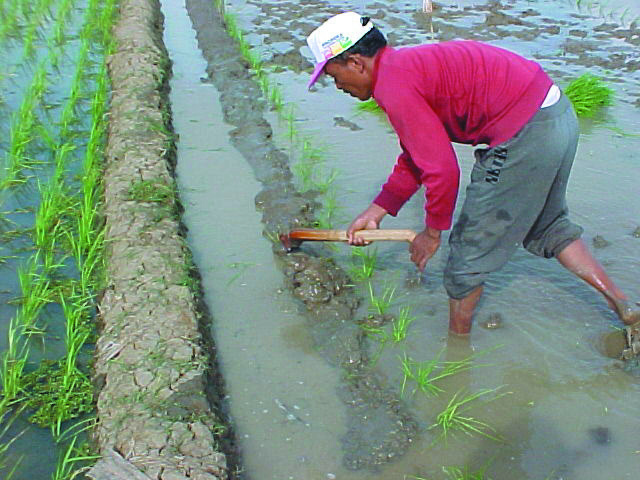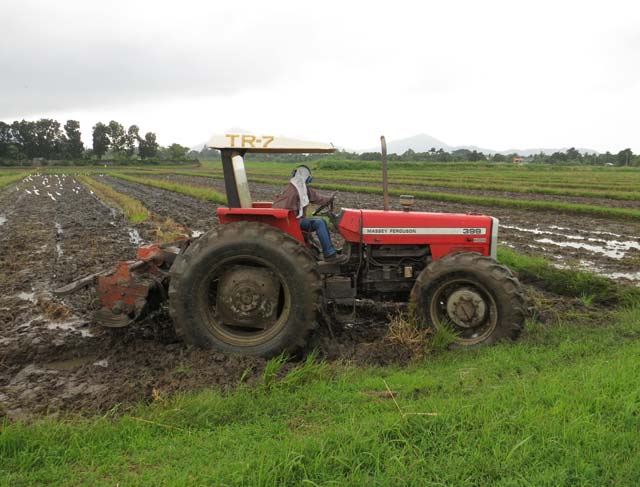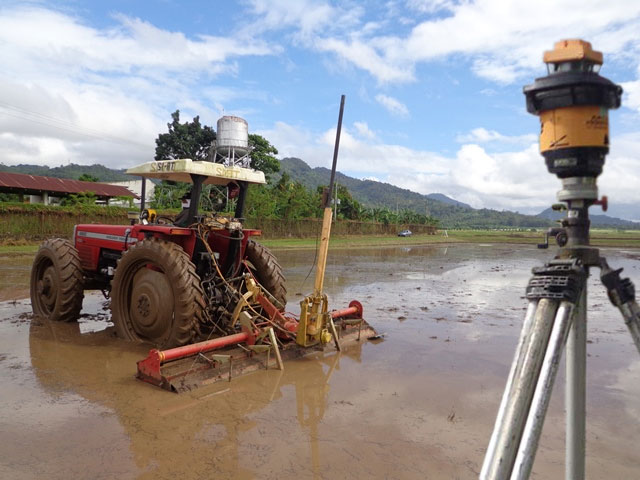Wet Preparation
 Wet preparation is the most common way of preparing lowland fields. In this method, the soil is tilled in a saturated or flooded condition.
Wet preparation is the most common way of preparing lowland fields. In this method, the soil is tilled in a saturated or flooded condition.
It helps improve weed control and facilitates incorporation of nutrients in the soil. With its nature, wet preparation has a high water requirement.
The following are the steps and processes involved in wet preparation:
 Repair or construct bunds
Repair or construct bunds
Bunds or dikes enable the field to hold water. This is important especially in areas where water supply is not reliable.

- Construct no wider and taller than 50 cm x 30 cm bunds, around the field.
- Make sure that bunds are well compacted and properly sealed, with no cracks, holes, etc. This will minimize water losses through seepage (particularly in sloping lands).
- Adjust the spillway height to 3−5 cm for storing the same depth of water. Maintain this height to ensure sufficient water storage capacity especially during rainy or wet season.
For rat control, construct 30 cm x 30 cm bunds.
 Irrigate the field
Irrigate the field
Irrigate the field with 2−3 cm of water for about 3−7 days or until it is soft enough and suitable for an equipment to be used.
 Perform primary tillage operations
Perform primary tillage operations
 Primary tillage is normally undertaken when the soil is wet enough to allow the field to be plowed and strong enough to give reasonable levels of traction. This can be immediately after harvest or at the beginning of the next season, depending on soil moisture and water availability.
Primary tillage is normally undertaken when the soil is wet enough to allow the field to be plowed and strong enough to give reasonable levels of traction. This can be immediately after harvest or at the beginning of the next season, depending on soil moisture and water availability.
- Plow the field.
Implement options:
Power: 4-wheel tractor / 2-wheel tractor / animal power
Attachments: moldboard plow / disc plow / rotavator
Make the first pass along the edges of the field in a clockwise pattern. For the second pass, move counterclockwise and finish at the center.
Read: What are the different plowing patterns? (Training resource)
The soil should be plowed to attain a reasonable depth (10−20 cm of cultivated soil) with varying clod sizes, and to kill weeds by burying or exposing the roots.
Depending on the clod size, another tillage operation can be done using primary tillage implements. Additional primary tillage operations are generally done with disc plow or rotavator.
What is rotary tilling?
Primary tillage may also be done through rotary tilling. A power tiller or tractor-mounted rotary tiller is used in this operation.
Tiller blades or knives completely cut and mix the soil. They also break up and shred plant stubble or weeds, speeding up the decay of plant materials.
Rotary tilling can be done during primary and/or secondary tillage of soil.
 Flood the field
Flood the field
Keep the field submerged for 10−14 days after plowing to soften clods and to decompose organic materials.
 Perform secondary tillage operations
Perform secondary tillage operations
 Depending on climate and soil type, this should be done 10−14 days after primary workings.
Depending on climate and soil type, this should be done 10−14 days after primary workings.
- Puddle the field.
Implements: Power tiller, Hydrotiller, Rotovator
Puddling works the soil into a muddy or watertight paste. This minimizes water loss and increases nutrient retention and availability.
- Harrow the field 2−3 times within 5−7 days interval.
Implements: Power tiller with attached comb-tooth harrow, Rotovator
Harrowing breaks up the soil clods and incorporates weeds, straw, and stubble into the mud. This hastens their decomposition.
Pass the harrow crosswise to break the soil clods. The second pass should be done lengthwise.
If the field is flooded, reduce the depth of the water to locate uneven and high surfaces of the soil before harrowing.
- Depending on soil and weed population, a field may require more than two harrowings.
The third and final harrowing aim to do initial land leveling and final incorporation of crop residues, and provide proper soil tilth for crop growth.
If using a small tractor or a draft animal, do the final harrowing with a plank leveler; if using a large tractor, use the rotavator and leveler, 2 days before planting.
 Level the field
Level the field
Leveling should be done two (2) days before planting.
Implements: Power tiller with attached wooden plank, Rotovator wide puddler with attached laser leveler
Use a wooden plank when leveling with a draft animal or small tractor. This requires total water coverage of the field for 12 days.When using a two-wheel tractor, 7−8 days of water coverage is required per hectare of land.
A leveled and smooth soil surface provides for uniform germination and growth of the crops. A well-leveled field improves water coverage and is also proven to increase crop yield and quality.
Read: Guide to laser leveling
You can also combine wet and dry tillage methods
Perform primary tillage operations on dry soil. Then, flood and puddle the field in the same way as wet tillage. Seeds can be direct seeded or transplanted into puddled soil.
A well-prepared rice field has the following characteristics:
- Mud and water are thoroughly mixed
- Weeds, rice straw, and stubble have been plowed under the soil and are thoroughly decayed
- Land is leveled